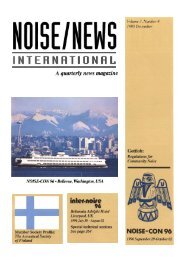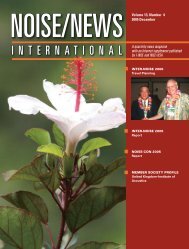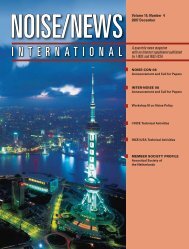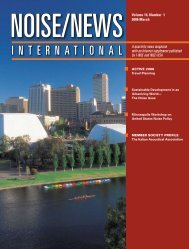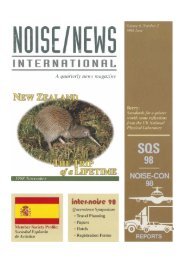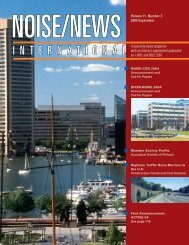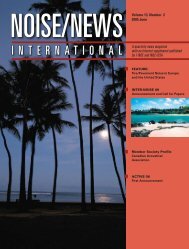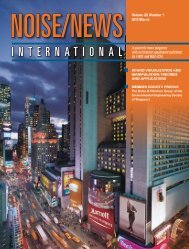Volume 6, Number 4, December, 1998 - Noise News International
Volume 6, Number 4, December, 1998 - Noise News International
Volume 6, Number 4, December, 1998 - Noise News International
You also want an ePaper? Increase the reach of your titles
YUMPU automatically turns print PDFs into web optimized ePapers that Google loves.
Pan-American <strong>News</strong><br />
George Maling, Pan-American Editor<br />
USA<br />
In <strong>1998</strong> August, the U.S. FederalAviation<br />
Administration (FAA) released the 1997<br />
Progress Report on the Transition to<br />
Quieter Airplanes. This is an edited version<br />
ofa portion ofthat report. The full<br />
reporr can be found on the Internet at<br />
http://www.aee.jaa.gov/aee-300/part91/<br />
96report/pt91-98.htm. - Ed. The full report<br />
is the sixth annual report submitted<br />
to Congress in response to 49 USC<br />
47528, which establishes a uniform policy<br />
at the national level to reduce aviation<br />
noise by expediting the phaseout ofStage<br />
2 airplanes and the transition to an all<br />
Stage 3 fleet. The full report presents airplane<br />
operators' compliance progress<br />
from January I, 1997, through <strong>December</strong><br />
31, 1997.<br />
The Airport <strong>Noise</strong> and Capacity Act<br />
of 1990 (ANCA) (now codified at 49<br />
USC 47521-47533) requires a phased<br />
elimination ofthe operation ofcivil, subsonic<br />
Stage 2 turbojet airplanes over<br />
75,000 pounds to or from airports in the<br />
contiguous United States by <strong>December</strong><br />
31, 1999. The statute also prohibits importation<br />
ofStage 2 aircraft after November<br />
11, 1990, but provides for<br />
U.S.-owned Stage 2 airplanes leased to<br />
foreign operators to be returned to operation<br />
in the United States.<br />
The regulations implementing the part<br />
ofi\NCA known as the Stage 3 transition<br />
rule were effective on September 25,<br />
1991, and are codified at 14 CFR part 91,<br />
Subpart I, Operating <strong>Noise</strong> Limits. The<br />
regulations provide two options to meet<br />
the schedule for the transition to 100 percent<br />
Stage 3 by <strong>December</strong> 31, 1999. One<br />
option allows an operator to meet the compliance<br />
schedule by phasing out Stage 2<br />
airplanes. Under this option, an operator<br />
ma y operate no more than 75 percent of its<br />
Stage 2 base level after <strong>December</strong> 31,<br />
1994,50percent after <strong>December</strong> 31, 1996,<br />
and 25 percent after <strong>December</strong> 31, <strong>1998</strong>.<br />
Base level is equal to the maximum number<br />
of owned or leased Stage 2 airplanes<br />
that were on an operator's operations<br />
specifications on a single day selected by<br />
the operator during the period January 1,<br />
1990, through July 1, 1991. The second<br />
option allows an operatorto meet the compliance<br />
schedule by attaining a fleet composition<br />
ofnot less than 55 percentStage 3<br />
airplanes after <strong>December</strong> 31, 1994, 65<br />
percent after <strong>December</strong> 31, 1996, and 75<br />
percent after <strong>December</strong> 31, <strong>1998</strong>. New entrant<br />
operators (those that did not conduct<br />
operations on or before November 5,<br />
1990) must operate a fleet composed of at<br />
least 25 percent Stage 3 airplanes after <strong>December</strong><br />
31, 1994, 50 percent after <strong>December</strong><br />
31, 1996, and 75 percent after<br />
<strong>December</strong> 31, <strong>1998</strong>. All operators must<br />
operate 100 percent Stage 3 fleets after<br />
<strong>December</strong> 31, 1999.<br />
The statute provides that a domestic<br />
air carrier may apply to the Secretary of<br />
Transportation for a limited waiver beyond<br />
the statutory deadline. The implementing<br />
regulations provide for the grant<br />
ofa waiver by the FAA at an interim compliance<br />
date if a petitioner can show,<br />
among other criteria, that a grant of a<br />
waiver would be in the public interest. A<br />
petitioner must also show that a reasonable<br />
plan to meet compliance was established<br />
and that a good faith effort was<br />
made to implement that plan.<br />
The composite data derived from the<br />
1997 operator reports show that the number<br />
of Stage 2 large civil subsonic turbojet<br />
airplanes operating in the contiguous<br />
United States continued to decline. By the<br />
end of 1996, domestic and foreign operators<br />
had collectively phased out 44.7 percent<br />
of the Stage 2 airplane fleet. In 1997,<br />
this figure increased by 6.9 percent for a<br />
total cumulative Stage 2 fleet reduction of<br />
51.6 percent from base level. Stage 2 airplanes<br />
are being modified to meet Stage 3<br />
noise levels or are being replaced by new<br />
Stage 3 airplanes designed with the latest<br />
quiet technology. The number of Stage 3<br />
airplanes operating in the United States is<br />
increasing. By the end of 1996, Stage 3<br />
airplanes constituted 75.5 percent of the<br />
combined domestic and foreign operator<br />
fleets of large turbojet airplanes operating<br />
to and from U.S. airports. In 1997, this fig-<br />
ure increased by 4.3 percent for a total<br />
Stage 3 fleet of 79.8 percent.<br />
The FAA is monitoring each operator's<br />
progress toward meeting the interim<br />
compliance requirements. The agency<br />
also monitors domestic operators' progress<br />
against their stated compliance plans<br />
through direct communication and provides<br />
for contact with foreign operators<br />
and foreign civil aviation officials to ensure<br />
that they are aware of and prepared<br />
to meet the interim compliance requirements.<br />
Compliance monitoring is an ongoing<br />
effort with the goal of assisting<br />
operators in achieving interim compliance<br />
deadlines.<br />
Eriksson Research is Founded. Dr.<br />
Larry 1. Eriksson has announced the formation<br />
ofEriksson Research, LLC, an interdisciplinary<br />
research and consulting<br />
company. The company will focus on assisting<br />
organizations in the application of<br />
adaptive approaches to management,<br />
technology, and education through research,<br />
presentations, seminars, short<br />
courses, and consulting. This will include<br />
a broad range of product research and development<br />
applications using adaptive<br />
systems technology as well as the application<br />
ofthese adaptive concepts to management<br />
issues. Dr. Eriksson's previous<br />
work has led to the creation of a wide<br />
range of adaptive control technology and<br />
products as well as the formation of<br />
Digisonix, a leader in the application of<br />
adaptive technology to active sound and<br />
vibration control and digital communications<br />
systems. More recently, he has been<br />
expanding the application of these concepts<br />
to management issues as well. Previously<br />
he was Vice-president ofresearch<br />
for Nelson Industries, Inc., and following<br />
the recent purchase of Nelson by the<br />
Cummins Engine Company, he was the<br />
Chief Technical Officer of the<br />
FleetguardlNelson Filtration and Acoustics<br />
Systems unit. Dr. Eriksson is a Fellow<br />
ofthe Acoustical Society of America and<br />
the Society of Automotive Engineers.<br />
The company Internet site IS<br />
http://www.execpc.coml-erikres.<br />
19'~8 <strong>December</strong><br />
<strong>Noise</strong>l<strong>News</strong><strong>International</strong><br />
227



